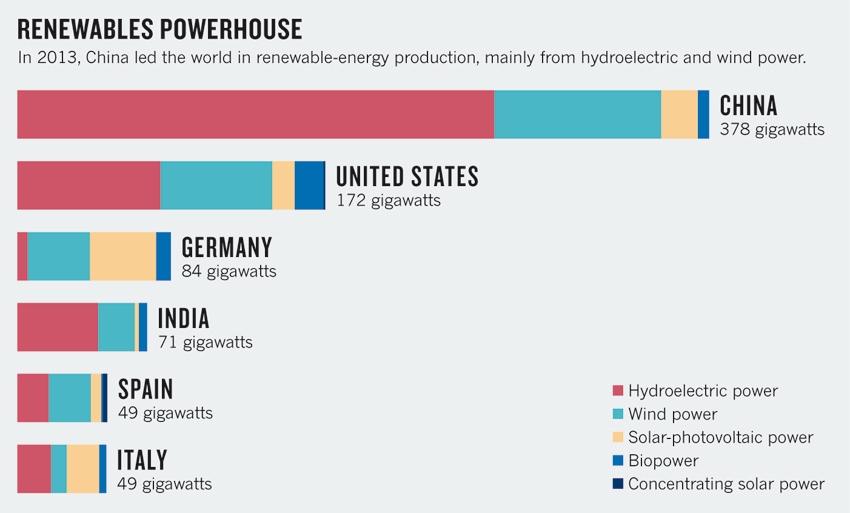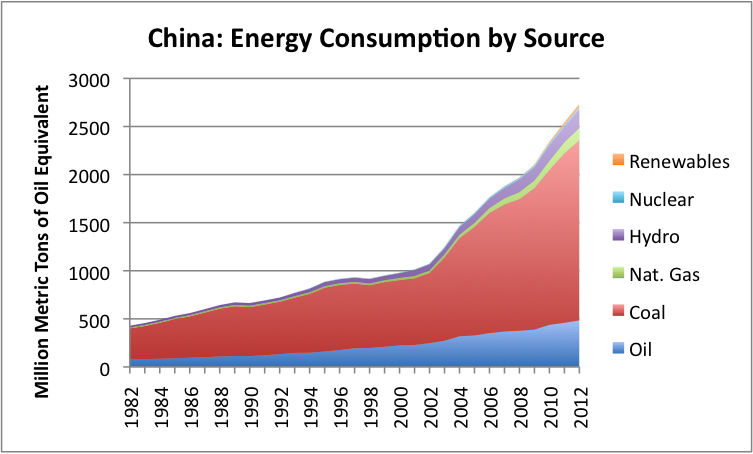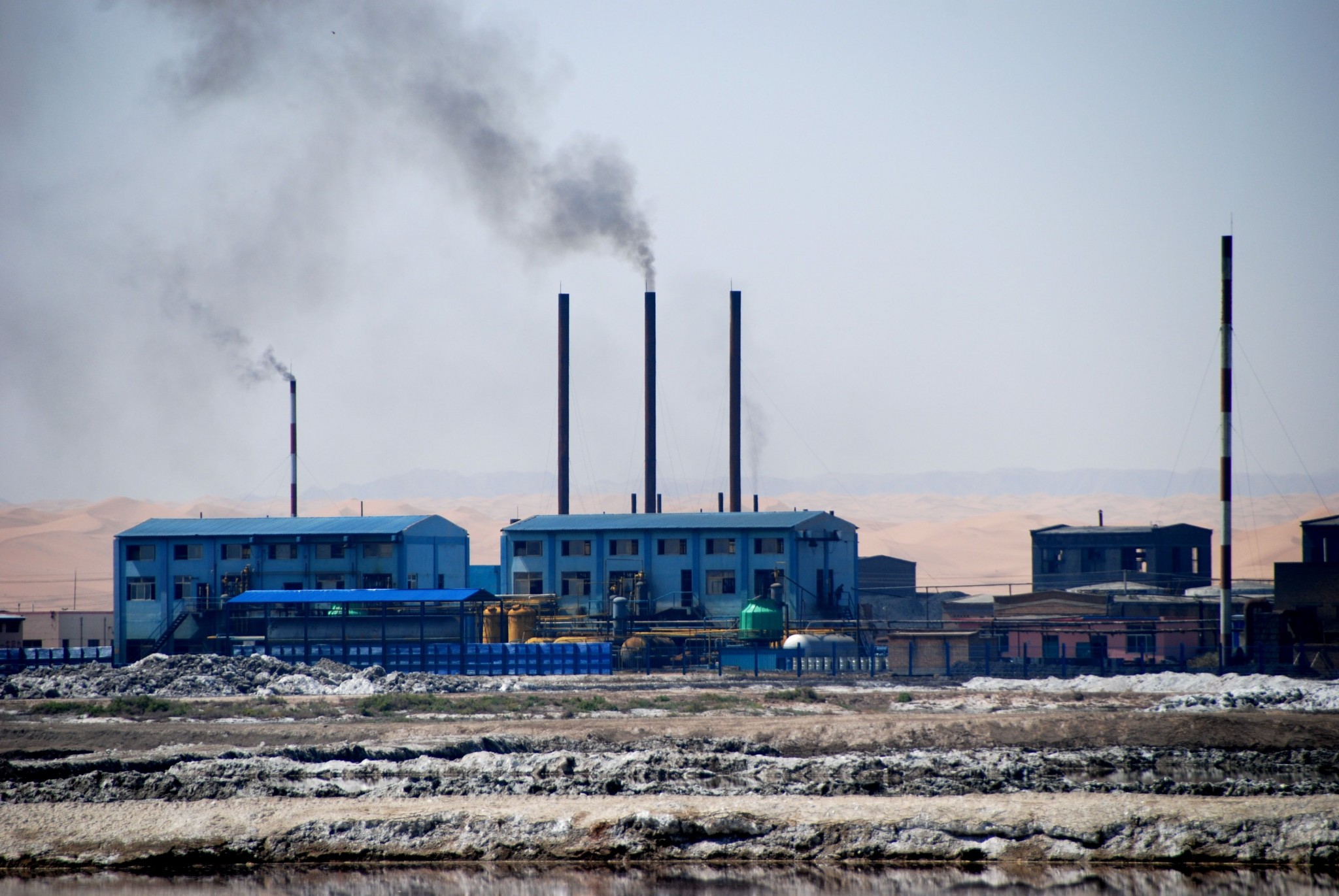History of Renewable Energy in China
Though China has faced centuries of environmental issues, it wasn’t until the early 1970’s — during the beginning of the post-Mao, post-isolationist reform era — that rapid economic development and fossil fuel usage heralded in unprecedented levels of pollution and degradation (Mu, 2014).

Developing renewable energies will allow China to mitigate the damages provoked by their intensive fossil fuel usage, both in terms of local pollution and global climate change.
The adoption of low-carbon infrastructure has a strong potential to provide China with a global competitive advantage, minimize the costs of importing coal and petroleum, and secure them funding from global sustainable development mechanisms (Harris 2011: Ding 2008).
Therefore, though economic development continues to be prioritized, over the past few decades China has indeed began implementing an increasing number of renewable projects and policies.
While the majority of early efforts focused on rural electrification, by the mid-2000’s renewable energy development shifted to a focus on bulk generation within centralized power grids (Martinot, 2010).
As of 2010, China was the global leader in wind turbine production, solar PV production, and total power capacity from renewable energy (Martinot, 2010).

Legislation & Policy Initiatives
| Notable Legislation |
- The Renewable Energy Law of 2006 : Widely heralded as a landmark piece of legislation in the Chinese renewable energy sector, this law established the preliminary national framework for promoting clean energy in China. More specifically, it aimed to integrate renewables into China’s energy system, develop renewable markets and remove economic barriers, and heighten environmental awareness and technological skills (Martinot, 2010).
- Promoting the Wind Electricity Industry program (2006): Offered preferential regulations for the development of wind power (Cooke, 2012).
- Golden Sun Program (2009): Provided subsidies, technological support, and market incentives structured to boost the development of the solar industry (Cooke, 2012)
- The Eleventh (2006-2010) and Twelfth (2011-2015) Five-Year Plan: China’s regular series of Five-Year plans outline strategic initiatives for social and economic development and provide indicators of China’s priorities. In these two recent national plans, a significant degree of attention was given to issues of energy conservation and emissions reduction (Li, 2016)

Credit: The Climate Group Flickr
| Legislative Issues |
- Prioritizing Production over Usage: Overall, implemented policies have focused mainly on scaling up the production of renewable energy technologies rather than on their generation, distribution, and consumption (Zhang, 2013). China must continue to grow their personal utilization of clean fuels and increase the percentage of energy supplied by renewable sources.

- Lack of Enforcement: Furthermore, though policies are often progressive, they are unfortunately not always enforced. Weak and disjointed government institutions are unable or unwilling to enforce energy laws, and unpunished disobedience of industries and businesses further impedes actual progress (Mu, 2014). Therefore, China must work on improving government enforcement abilities and industry compliance levels going forward.
Geographical & Scientific Context
The geographical makeup of a nation is an essential determinant of their ability to produce renewable energy resources. Indeed, resources such as wind, solar, and hydropower largely depend on land’s natural geography. For example:
- Wind: The strong winds in the grasslands of Inner Mongolia make the area particularly suited to the usage of wind power (Shapiro, 2016).
- Solar: The sun-drenched region of Tibet enables the wide-spread adoption of solar technologies in this area (Shapiro, 2016).
- Hydropower: Around 70% of hydropower resources are distributed in the southwestern portion of China, and are largely clustered around major rivers such as the Yangtze and Yellow River (Wang, 2009).

Credit: Land Rover Our Planet. Flickr.
| Geographical & Scientific Issues |
- Abundance of natural coal: China hosts a large amount of coal — one of the cheapest and dirtiest fossil fuels — which makes it a resource that is all to easy to exploit (Shapiro, 2016).
- Inadequate scientific and technological capacities: China is over a decade behind developed countries in terms of renewable energy exploration, production, and distribution techniques (Ding, 2008). This low level of technological capacity and sophistication reduces China’s energy efficiency by about 10% compared with developed countries, and severely hinders the transition to a low-carbon economy (Ding, 2008).
Community Demographics
A significant facet of privilege at work in terms of China’s renewable energy development is the wealth divide between China’s citizenry. With wealth comes political capital, and residents of wealthy Eastern cities such as Beijing have the privilege to demand high levels of pollution control and the relocation of heavily polluting factories (Shapiro, 2016). Environmental problems and toxins are then displaced to surrounding areas, which are habitually rural, poor, and comprised of minority ethnic groups (Li, 2016).

Credit: Bert van Dijk, Flickr
Meanwhile, the bulk of China’s consumption still occurs within wealthy eastern regions such as Beijing and Shanghai, whose consumption levels and energy requirements are several times that of their direct energy production (Li, 2016). On the other hand, poorer western areas, such as Inner Mongolia, produce much more energy than they consume, and are thusly forced to bear the environmental burdens of factories and support the elites’ consumption while reaping little for themselves (Li, 2016).
________________________________________________________
Reference List:
Ding, D., Dai, D., & Zhao, M. (2008). Development of a Low-Carbon Economy in China. International Journal of Sustainable Development and World Ecology, 15 (4), 331-336. Retrieved from http://search.proquest.com/docview/198052314?accountid=10207
Cooke, P., Parrilli, M. D., & Curbelo, J. L. (2012). Innovation, Global Change and Territorial Resilience. Cheltenham, UK: Edward Elgar.
Harris, P. G. (2011). China’s responsibility for climate change: Ethics, fairness and environmental policy. Bristol, UK: Policy Press.
Li, J., Xia, X., Chen, G., Alsaedi, A., & Hayat, T. (2016). Optimal embodied energy abatement strategy for Beijing economy: Based on a three-scale input-output analysis. Renewable & Sustainable Energy Reviews, 1602-1610. doi:10.1016/j.rser.2015.09.090
Martinot, E. (2010). Renewable Power for China: Past, Present, and Future. Frontiers of Energy and Power Engineering in China, 4 (3), 287-294. doi:http://dx.doi.org/10.1007/s11708-010-0120-z
Mu, Z., Bu, S., & Xue, B. (2014). Environmental Legislation in China: Achievements, Challenges and Trends. Sustainability, 6(12), 8967-8979. doi:10.3390/su6128967
Shapiro, J. (2016). China’s environmental challenges.
Zhang, S., Andrews-Speed, P., Zhao, X., & He, Y. (2013). Interactions between renewable energy policy and renewable energy industrial policy: A critical analysis of China’s policy approach to renewable energies. Energy Policy, 342-353. doi:10.1016/j.enpol.2013.07.063
Wang, Z., & Li, J. (2009). China’s Renewable Energy Development. International Journal of Energy Sector Management, 3(1), 50-61. doi:http://dx.doi.org/10.1108/17506220910947845
Images:
BP. (n.d.). BP Statistical Review of World Energy June 2016. https://www.bp.com/content/dam/bp/pdf/energy-economics/statistical-review-2016/bp-statistical-review-of-world-energy-2016-full-report.pdf
Fulcher, M. (n.d.). Pollution China [Photograph]. Flickr, Shanghai. https://www.flickr.com/photos/maxful/5256399555/in/photolist-935ZSC-91uqsx-eixGmM-e9wcz2-dkUZwk-91xyhJ-ecngAp-8Z2ZjV-9c8Len-932V7x-naSW43-93627Q-djWKcc-jL5H77-dG7gkm-axsrwc-naoT4t-8Z66aS-9fTxix-932WuR-8Z32Pk-8ZpFn1-91bW9T-8ZpD7Y-9365Yo-91xxeG-8ZmBcc-91uqcv-9361iS-91upSZ-9fQgK2-9361vU-bcehSF-9g4M2S-8Z318M-9fWDu7-9gqgMm-91f4sf-9366QQ-8ZmBiR-936451-8Z32Me-91f4FQ-9365LU-9fTy7H-932XKP-91bWeH-932WaX-9364Xj-9g1EGF
Land Rover Our Planet. (n.d.). Ningxia Wind Farm [Photograph]. Flickr, Ningxia Province. https://www.flickr.com/photos/our-planet/5384224028
REN21 (2014). Renewables 2014 Global Status Report (Paris: REN21 Secretariat). http://www.ren21.net/Portals/0/documents/Resources/GSR/2014/GSR2014_full%20report_low%20res.pdf
Van Dijk, B. (n.d.). Factory in Inner Mongolia [Photograph]. Flickr.https://www.flickr.com/photos/zilpho/3861795539
